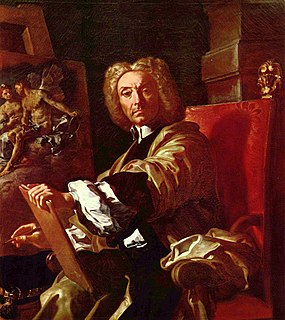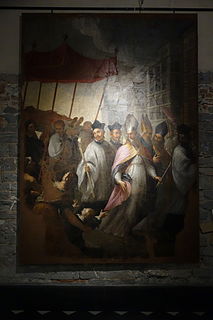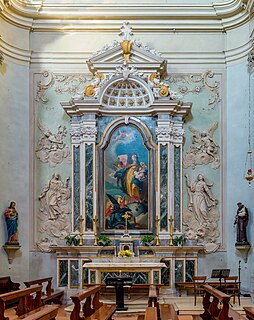Related Research Articles

Francesco Solimena was a prolific Italian painter of the Baroque era, one of an established family of painters and draughtsmen.

Pietro (Libertino) Liberi was an Italian painter of the Baroque era, active mainly in Venice and the Veneto.

Jacopo Zucchi was a Florentine painter of the Mannerist style, active in Florence and Rome.

Andrea Vaccaro was an Italian painter of the Baroque period. Vaccaro was in his time one of the most successful painters in Naples, a city then under Spanish rule. Very successful and valued in his lifetime, Vaccaro and his workshop produced many religious works for local patrons as well as for export to Spanish religious orders and noble patrons. He was initially influenced by Caravaggio, in particular in his chiaroscuro and the naturalistic rendering of his figures.

Girolamo Marchesi was an Italian painter of the Renaissance period.

Giovanni Raffaele Badaracco (1648–1726) was an Italian painter of the Baroque period. He was born in Genoa, son and pupil of the painter Giuseppe Badaracco. After studying some time under his father he went to Rome, and entered the school of Carlo Maratta. He also painted in Naples and Venice, then returned to Genoa.
Lazzaro Calvi (1512–1587) was an Italian painter of the late-Renaissance period. He was born in Genoa and trained with his father Agostino Calvi and Perin del Vaga. Older sources claim he lived till the improbable age of 105 years

Bartolomeo Nazari was an Italian painter of the late-Baroque, mainly active in Venice as a portraitist.

Giovanni Battista Merano (1632-1698) was an Italian painter of the Baroque period, mainly active in Genoa.

Francesco da Cotignola, also called Zaganelli, was an Italian painter of the Renaissance period, active mainly in Parma and Ravenna.

Giovanni Battista Innocenzo Colombo was a Swiss painter and stage set designer.
Mauro Aldrovandini (1649–1680) was an Italian painter of the Baroque period. While he was most active in Bologna, and some claim he was native to the city, others claim he was born in Rovigo. He mainly painted perspective views and architectural subjects (quadratura) in private houses and for theaters.
Bernardino Lanzani was an Italian painter of the Renaissance, active mainly in Pavia and Bobbio.
Giacomo Coltrini was an Italian painter, active mainly in a Renaissance style in Brescia, and a military engineer for Venetian Republic. He painted frescoes for the subterranean church of San Faustino Maggiore in Brescia. He died as a military engineer in Candia. Titian's paternal uncle, Gregorio Vecelli, lived in Coltrini's house in Venice.
Francesco Comande was an Italian painter of a Renaissance style, born and active in Messina, Sicily.

Francesco Lorenzi was an Italian painter of the late Baroque period.
Jacopo Loschi or Jacopo d' Ilario Loschi was an Italian painter.

Nicola Vaccaro was an Italian painter, theatre director and opera librettist in Naples. He was known for his religious and allegorical paintings who created easel paintings as frescos. He was a specialist figure painter who regularly collaborated with specialist still life painters on decorative Baroque still lifes and garland paintings. Vaccaro attempted to adapt the stylistic features of 17th-century Neapolitan tradition to the new Classicist and Baroque trends towards increasing Arcadian tendencies. He proposed his own specific form of Academism, aimed at revitalizing the figurative culture in Naples.

Francesco Mancini-Ardizzone was an Italian painter. He painted diverse subject matter, including portraits, genre, and sacred subjects, as well as landscapes and seascapes of the Southern Italian and Sicilian coasts.
Orazio Brunetti was an Italian engraver and painter, active mainly in Rome.
References
- Bryan, Michael (1886). Robert Edmund Graves (ed.). Dictionary of Painters and Engravers, Biographical and Critical. Vol. I.: A-K. London: George Bell and Sons. p. 10.
- Video on restoration of Oratory of San Nicola.
- ↑ Boni, Filippo de' (1852). Biografia degli artisti ovvero dizionario della vita e delle opere dei pittori, degli scultori, degli intagliatori, dei tipografi e dei musici di ogni nazione che fiorirono da'tempi più remoti sino á nostri giorni. Seconda Edizione.. Venice; Googlebooks: Presso Andrea Santini e Figlio. p. 9.
- ↑ Rosand, Ellen (1991). Opera in seventeenth-century Venice the creation of a genre. Berkeley, Calif.: University of California Press. p. 73. ISBN 9780520934566.